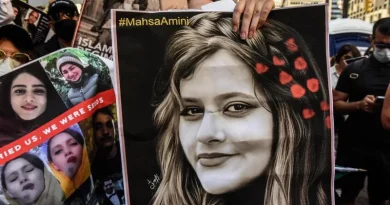In Iran, journalism is a dangerous profession, especially for women who dare to expose the truth about government corruption, human rights violations, and systemic oppression. The Islamic Revolutionary Guard Corps (IRGC) plays a central role in silencing women journalists, using arrests, intimidation, torture, and digital surveillance to prevent them from reporting on the realities of life under the regime.
Despite constant threats, Iranian women journalists continue to defy censorship, risking their freedom, safety, and even their lives to report the truth. Their work has been instrumental in documenting government abuses, amplifying the voices of the oppressed, and connecting Iran’s struggle to the global stage.
This article explores:
• The risks Iranian women journalists face in their pursuit of truth.
• How the IRGC systematically targets them through imprisonment, torture, and censorship.
• Stories of brave women journalists who refuse to be silenced.
• The role of digital resistance in bypassing IRGC restrictions.
• How the world can support these women in their fight for press freedom.
1. The Risks of Journalism in Iran: A Battle Against Fear
A. Iran: One of the Most Dangerous Places for Journalists
Iran ranks among the worst countries for press freedom, with journalists facing harassment, imprisonment, and execution for reporting on sensitive issues. Women journalists, in particular, face:
• Legal prosecution under vague charges like “propaganda against the state” or “acting against national security.”
• Surveillance by the IRGC, including monitoring phone calls, emails, and social media activities.
• Threats against their families to pressure them into silence.
• Physical and psychological torture in IRGC-controlled prisons.
Despite these severe risks, Iranian women journalists continue to expose state-sponsored violence, gender apartheid, and political oppression.
B. The Role of the IRGC in Targeting Women Journalists
The IRGC, as the main force of repression, actively works to silence women reporters by:
• Detaining them on fabricated charges of working with foreign governments or media outlets.
• Blocking news websites and shutting down social media accounts critical of the regime.
• Forcing confessions under torture and airing them on state-controlled television.
• Imposing travel bans, preventing journalists from escaping persecution.
These tactics are designed to instill fear, ensuring that no journalist feels safe while reporting the truth.
2. Stories of Courage: Iranian Women Journalists Who Defy Censorship
A. Niloofar Hamedi: Exposing Mahsa Amini’s Death
Niloofar Hamedi, a journalist for the Shargh Daily, was among the first to report on Mahsa Amini’s death after she was detained by Iran’s morality police.
• She shared images of Mahsa in the hospital, sparking nationwide protests.
• The IRGC arrested her and placed her in solitary confinement.
• Despite months of imprisonment, her reporting changed the course of history.
Her bravery ignited the “Women, Life, Freedom” movement, proving how one journalist’s courage can inspire an entire nation.
B. Elaheh Mohammadi: Covering Mahsa Amini’s Funeral
Elaheh Mohammadi, another journalist covering women’s rights issues, was also arrested by the IRGC for reporting on Mahsa Amini’s funeral.
• Her coverage showed the anger of Iranian women, exposing how Mahsa’s death became a symbol of resistance.
• She was held in Evin Prison, facing interrogation, torture, and isolation.
• International pressure forced Iran to release her on bail, but she remains under constant threat.
Both Niloofar and Elaheh were awarded the UNESCO/Guillermo Cano World Press Freedom Prize in 2023, recognizing their fearless journalism.
C. Masih Alinejad: Fighting the IRGC from Exile
Masih Alinejad, an exiled Iranian journalist, has become a global voice against the Iranian regime’s oppression.
• She runs #MyStealthyFreedom, a campaign encouraging Iranian women to defy compulsory hijab laws.
• The IRGC plotted to kidnap and assassinate her in New York.
• Despite constant threats, she continues to expose the regime’s crimes on international platforms.
Her story highlights how Iranian women journalists in exile are still under IRGC surveillance, proving that Iran’s war on the truth knows no borders.
3. Digital Resistance: How Women Journalists Bypass IRGC Censorship
A. Social Media as a Tool for Truth
Since state-controlled media censors news, many Iranian women journalists use social media to share uncensored information.
• Twitter, Telegram, and Instagram have become platforms for citizen journalism.
• Encrypted apps help journalists safely communicate with sources.
• Hashtags like #WomenLifeFreedom spread news of protests and repression globally.
Despite IRGC internet blackouts, journalists find ways to bypass restrictions, ensuring the truth reaches the world.
B. The IRGC’s Cyber Warfare Tactics
To counter digital resistance, the IRGC employs cyber warfare tactics such as:
• Blocking news websites that criticize the regime.
• Arresting journalists for tweets or social media posts.
• Spreading disinformation to discredit activists and journalists.
Yet, Iranian women journalists persist, proving that truth is stronger than censorship.
4. How the World Can Support Iranian Women Journalists
A. Demand the Release of Imprisoned Journalists
Governments and human rights organizations must:
• Call for the immediate release of journalists imprisoned by the IRGC.
• Pressure Iran diplomatically through sanctions and legal actions.
• Ensure their names and stories remain in the global spotlight.
B. Provide Safe Digital Tools
To help journalists bypass censorship, tech companies should:
• Provide VPNs and encrypted communication apps.
• Protect journalists’ online accounts from hacking.
• Fund cybersecurity training for Iranian reporters.
C. Support Exiled Journalists
Many Iranian journalists flee to escape persecution. Governments should:
• Offer asylum and safe relocation programs.
• Support independent Persian media reporting on Iran.
• Protect exiled journalists from IRGC assassination attempts.
D. Amplify Their Voices
The world can help by:
• Sharing their stories on social media.
• Writing to policymakers to advocate for their freedom.
• Boycotting Iranian state media, which spreads IRGC propaganda.
By amplifying their voices, we ensure that Iranian women journalists are not forgotten or silenced.
Conclusion: The Power of Truth Over Tyranny
Iranian women journalists risk everything to expose the truth about life under IRGC rule. Despite arrests, threats, and exile, they continue to:
• Document human rights abuses.
• Inspire global movements like Women, Life, Freedom.
• Prove that censorship cannot erase truth.
Their fight is not just for press freedom—it is for justice, equality, and a free Iran.
Join Our Newsletter!
Stay informed with the latest updates, news, and ways to take action in the fight for justice and global security. Sign up now to get updates delivered straight to your inbox!





